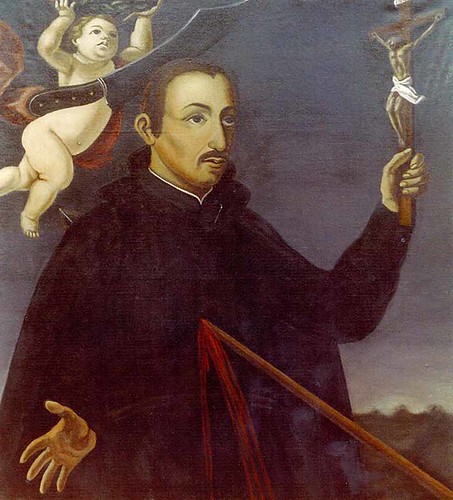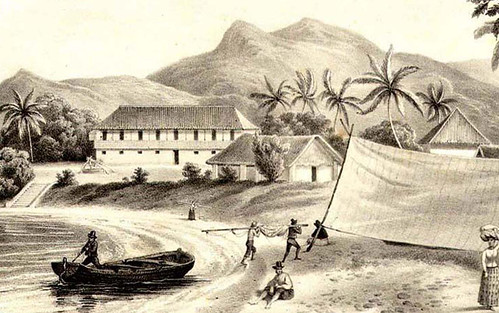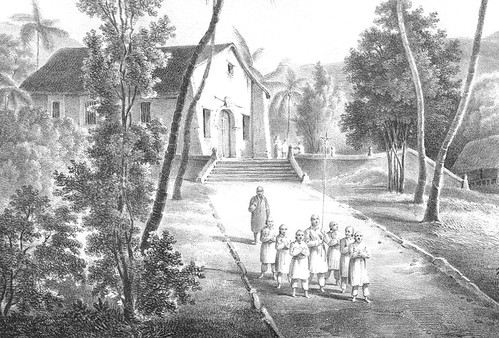Education and Christianization
First Catholic schools
In addition to the evangelization of the Mariana Islands, the Jesuits introduced a European system of education to Chamorros. The Colegio de San Juan de Letrán, a school for boys in Hagåtña, was established by Father Diego Luis de San Vitores, a Jesuit priest who arrived on Guam in 1668 and established the first Catholic mission in the capital city of Hagåtña.
The administration of the other schools on the island was overseen by the Council for Public Education (Junta de Enseñanza Pública) that was comprised of the governor, the parish priest of Hagåtña and the judge of the first instance.
In all of the schools, the students received lessons in religion, reading, writing, Castilian Spanish, and mathematics as well as the more practical skills of forging, carpentry, and agriculture.
Christianization was first priority
The early missionaries in the Mariana Islands baptized thousands of Chamorros. Despite resistance among many Chamorros and the widespread blood shed and death that resulted, a majority of the population of the Marianas throughout the first century of Spanish rule in the islands were eventually converted to Christianity.
San Vitores arrived with a contingent of Jesuit representatives, including Fathers Luis Medina and Pedro Casanova, as well as soldiers who were sent to provide protection for the priests. The Jesuit missionaries and the soldiers lived together in a small building constructed out of perishable materials (camarín) in Hagåtña. Quipuha, a leading high status Chamorro recognizing the gain he could reap from close ties with the Europeans, welcomed the Jesuits into his home and was the first Chamorro adult baptized by the Jesuits.
Father San Vitores had the first church on the island built and dedicated it to the Sweet Name of Mary (Dulce Nombre de María). The church was constructed out of stone masonry and a tile roof and was completed in February 1669.
Eight Jesuits killed by Chamorros
During the early years of the Jesuit administration, Chamorros and Christian missionaries engaged in clashes that at times resulted in violence. Between 1672 and 1684, eight Jesuit representatives lost their lives because of clashes caused by their efforts to spread the Catholic faith.
The Jesuits killed were:
- Father Diego Luis de San Vitores (1672)
- Father Francisco Esquerra (1674)
- Brother Pedro Diaz (1675)
- Father Antonio María de San Basilio (1676)
- Father Sebastían de Monroy (1676)
- Father Manuel Solórzano (1684)
- Father Teofilo de los Angeles (1684)
- Brother Baltasar Bubois (1684)
Many Chamorros were killed as a result of these clashes leading to a significant decline in the indigenous population. By 1674, more troops were sent to the island to help protect the missionaries and with them, Damian de Esplaña became the first commanding officer of the military troops.
Other Jesuit priests who helped to convert the people of the Marianas included Father Bustillos on Guam, Fathers Cardeñoso and Morales in Tinian, and Father Casanova in Rota.
Unexpectedly, after a century of service in the Marianas, in 1769 a royal decree ordered the removal of all Jesuits representatives from Spanish settlements. The Jesuit priests were soon succeeded by the Order of the Recollect Friars, also known as the Discalced Augustinians.
For further reading
Driver, Marjorie G. The Spanish Governor of the Mariana Islands and the Saga of the Palacio. Mangilao: Micronesian Area Research Center, University of Guam, 2005.
Ibañez y Garcia, Luis de. The History of the Marianas, with Navigational Data, and of the Caroline and Palau Islands: From the Time of their Discovery by Magellan in 1521 to the Present. Translated and annotated by Marjorie G. Driver. MARC Educational Series no. 12. Mangilao: Micronesian Area Research Center, University of Guam, 1992.
Santa María, Gregorio de. Reports Concerning the Mariana Islands: The Memorias of 1844-1852. Edited by Marjorie G. Driver and Omaira Brunal-Perry. MARC Educational Series no. 21. Mangilao: Micronesian Area Research Center, University of Guam, 1996.






